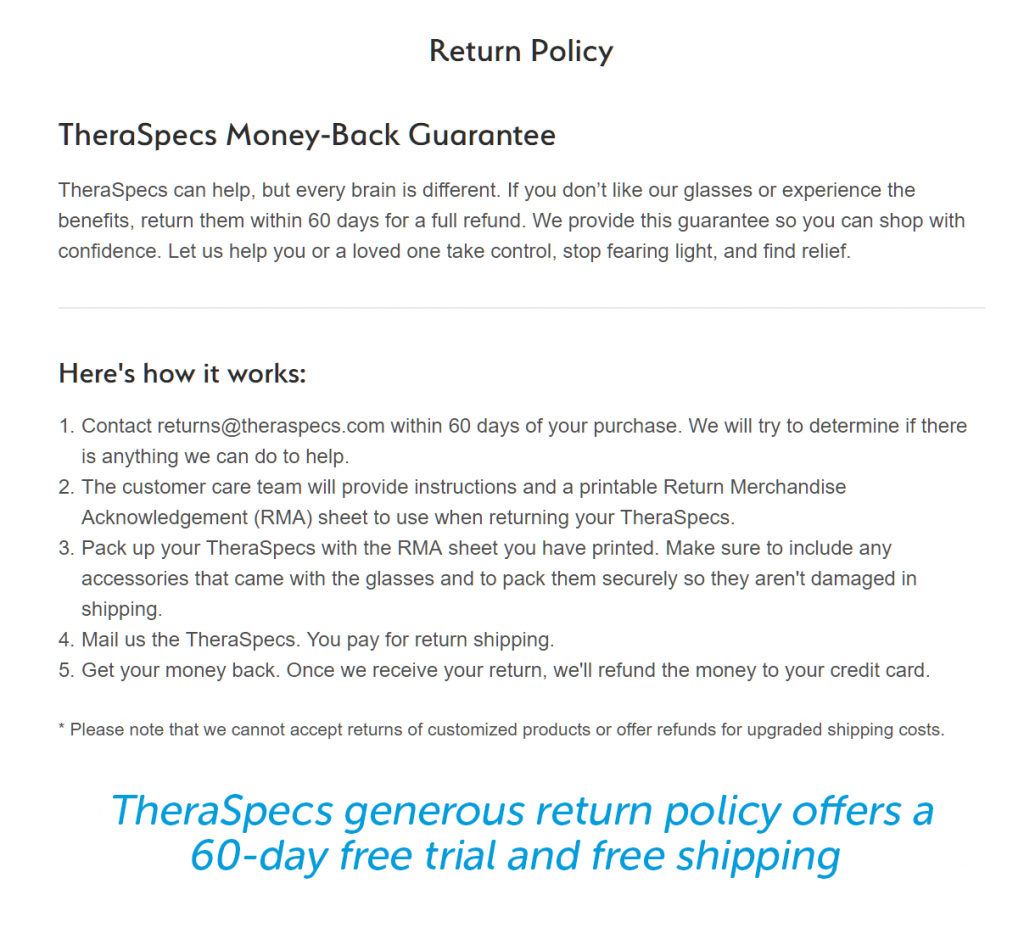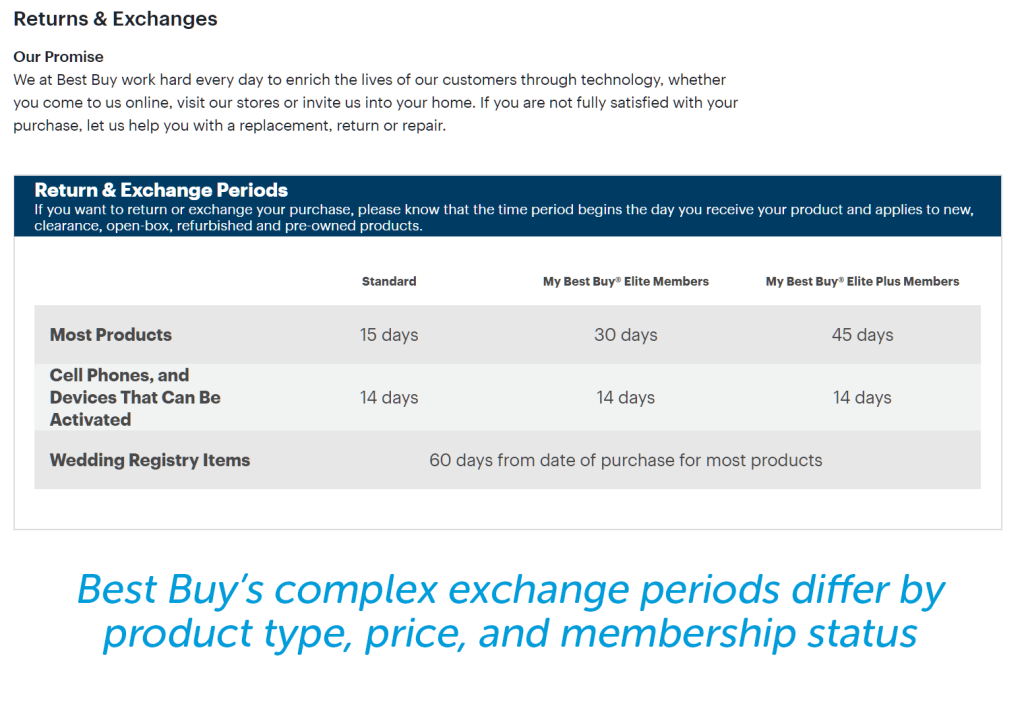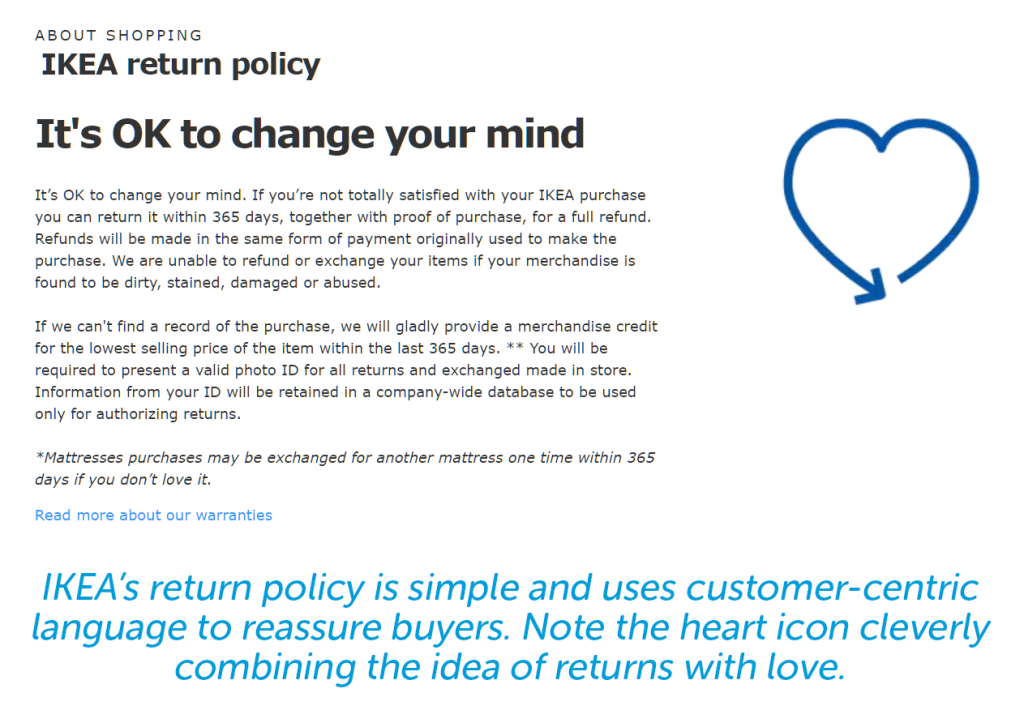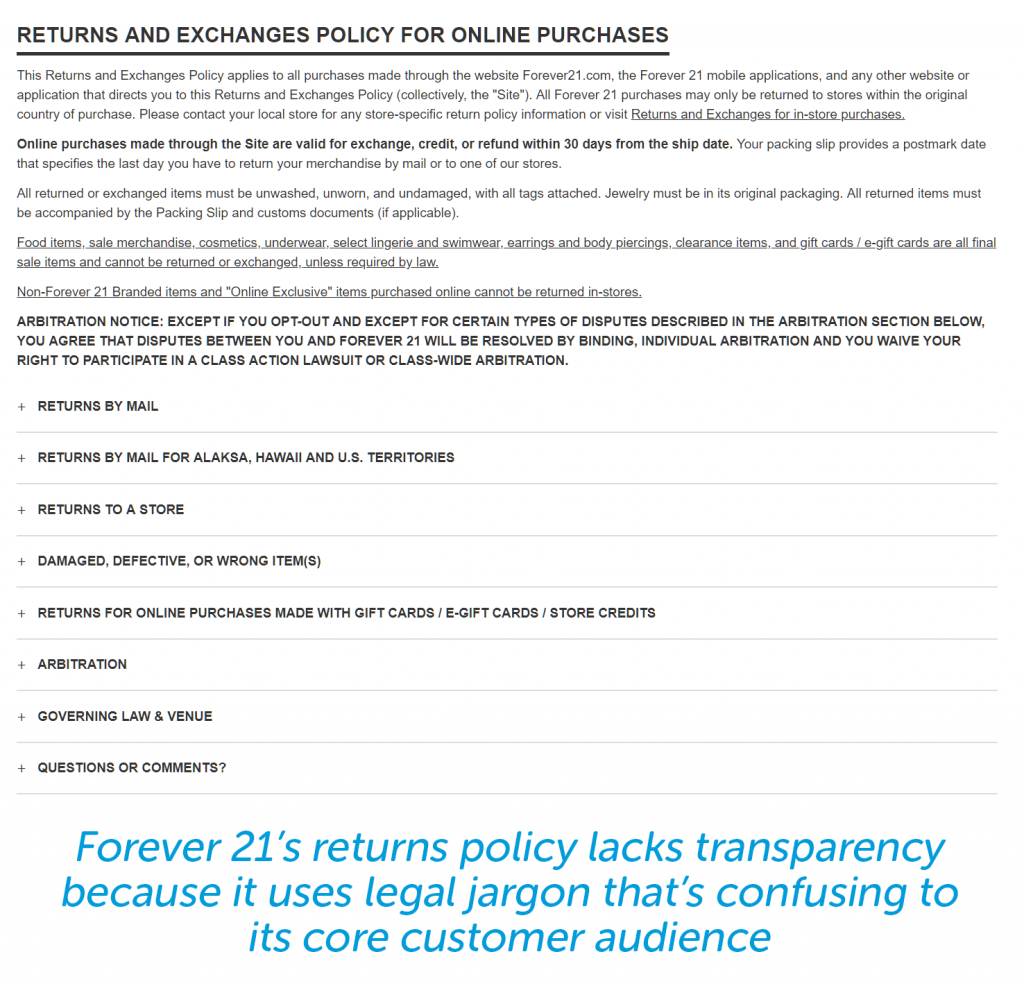TheraSpecs is an online eyewear vendor that makes tinted sunglasses designed to relieve the effects of migraines. Recently, facing a sharp spike in return rates, the company decided to extend their 45-day free trial.
“Even at 45 days, we found that customers who were on the fence were more likely to return their glasses because of the deadline,” Marketing Manager Greg Bullock explains.
TheraSpecs extended their free trial to 60 days. Those 15 extra days made a huge difference. Return rates stabilized, negative customer comments decreased, and most importantly, onsite conversion rates increased by 15 percent.
Bullock has this advice for eCommerce business owners:
Craft your return policy for your actual customer. Don’t base it solely on industry best practices, your competition, or what’s in your best interest.”

Good return policies strike a balance between bolstering consumer trust in your products and minimizing profit loss. Your return policy isn’t just a box to tick off—it actually says something about your brand.
If your policy is too strict, it engenders doubt in your products and you. Too complex, and it puts up roadblocks to purchase. Too technical sounding and you seem duplicitous.
Even Retail Giants Struggle to Find the Right Return Policy
In February 2018, L.L.Bean expired its famous lifetime guarantee, moving to a one-year return policy. In May 2018, Amazon announced it was changing its retail policy. The retail giant said it would ban customers who were abusing its liberal return policy and close their accounts.
The two famously customer-centric companies are trying to crack down on merchandise return fraud, which costs U.S. retailers an estimated $17.6 billion per year.
But will Amazon and L.L. Bean eliminate the cost of fraud, only to lose customers to retailers with more generous return policies? Only time will tell.
Keep Your Return Policy Simple
If you’re building or revamping your return policy, keep the terms and conditions simple. Even if you have to include some jargon and legalese to protect your interests, keep things as short as possible. Complex details, limitations, and extra fees confuse and anger customers, driving them away from product and checkout pages.
Best Buy’s return policy is a good example of terms and conditions getting out of hand. For example, the return and exchange periods vary by department. Some items have a return window of 14 days from the original date of purchase, while others have 15 days. Return day requirements also change with Best Buy membership levels (e.g., Best Buy Elite vs. Plus members).
Return costs also change by device—small electronics like cell phones cost $35, while DSLR cameras are 15% of the purchase price. Making customers do math is a huge purchase barrier. Restocking fees even differ depending on the brand of the cell phone!
Shipping costs are also convoluted, with Best Buy’s return policy making a distinction between free shipping for “Best Buy error” and customer-paid shipping for all other reasons. The policy even changes during the holiday shopping season. What’s a customer to do?

If Best Buy’s return policy resembles differential algebra, IKEA’s return policy is like third-grade math. You get 365 days to return an item for a full refund unless the item is “found to be dirty, stained, damaged or abused.” The returning customer only needs to present a photo ID and pay for shipping, pick up, or return it to an IKEA store. The company does change its policy to 90 days for pillows, quilts, and mattresses. But aside from that, IKEA’s return policy is easy to understand and follow.

Besides simplicity, IKEA’s return policy also benefits from copy that instills buyer confidence:
It’s OK to change your mind,” it begins. “If you’re not totally satisfied with your IKEA purchase you can return it…”. Note how the tone is empathetic, reassuring the customer it’s okay to be dissatisfied. It’s also customer-centric, addressing the customer directly. Contrast that with Best Buy’s beginning sentence—“We at Best Buy work hard every day…”—which puts the company first.
Be as Transparent as Possible
The quickest way to lose your customers’ trust is to have a return policy that surprises them with information they should have known before the purchase. Transparency is a non-negotiable quality in a return policy, and if absent, can negatively affect the most conscientious and ethical store owner’s bottom line.
You don’t need to intentionally hide extra fees inside small print disclaimers and asterisks to lack transparency.
Use Plain Language Your Audience Understands
Your return policy isn’t a place to drop your brand voice and adopt legalese—the words you use represent your brand just as much as the words on your homepage. Forever 21, a fashion brand that caters to teenagers and young adult audiences, doesn’t speak the same language as their customers when it comes to their return policy.

Forever 21’s introductory sentence says it all … while saying nothing at all:
This Returns and Exchanges Policy applies to all purchases made through the website Forever21.com, the Forever 21 mobile applications, and any other website or application that directs you to this Returns and Exchanges Policy (collectively, the “Site”).
The copy is too dense and cold, creating distrust and alienation in the customer. The real problem is that the return policy page changes the brand/customer relationship. The inviting words of Forever 21’s home page (e.g. “The brands we love”) isn’t carried over to their refund page—a place where “arbitration” and “governing law” create a formalized, legal relationship. This discontinuity in tone puts the customer on guard, engendering the feeling that there’s something fishy going on here.
In contrast, MapleHolistics.com is a brand that understands that a return policy needs to sound personalized, reassuring and on-brand. Here’s a sample from the skin and hair product vendor’s return policy. Note the inviting tone.
If you select a product for your own use and are, for any reason at all, not happy with the results—we will either replace it with a more suitable product, or give you a full refund (maximum of 2 refunds per household). It’s your choice—a choice well made knowing that we are dedicated to providing outstanding customer service and quality care.

MapleHolistics.com uses a return policy that’s simple and transparent. It contains contact information within the policy copy, which lets customers quickly ask questions. The policy also uses graphics to reassure customers, adding “Guaranteed Money Back” badges surrounding the “Holistic Promise”.
For Some Stores, No Refunds Is the Best Policy
The best policy for your store may be offering no refunds at all. Alex Tran is a fashion blogger and reviewer who also sells fashion from her personal collection on her website schimiggy.com. Tran says she doesn’t offer product returns at all.
I sell both new and used goods and let my buyers know that that is the nature of my store and its policies,” she says.
Tran, instead, leans on product images and descriptions to inform her customers about the condition of her items and build purchase trust.

Tran’s return policy is only five sentences long and is located right in the middle of her shopping page:
RETURN POLICY: All items are described as is in the listings. Due to all items coming from my personal closet, all sales are non-refundable. Please read the full description prior to purchasing. Thanks for your understanding. If you have any questions, please feel free to email me.
The no-refunds policy works well for influencers like Trans who use their own closets to stock their product pages. Since she’s a product reviewer, Trans succeeds only as much as she maintains trust and authenticity with her audience. It’s a level of trust that naturally transfers to her product descriptions too, removing customer doubts about the quality and authenticity of the clothes.
Overall, Trans’ return policy is simple, transparent, and trustworthy, and so far, it’s been successful. “I’ve had my store for a year now, and haven’t yet gotten a return from a disgruntled buyer,” she says. “As long as you are transparent about your business practices, most buyers will understand.”
Return Policies Reveal Who You Are
To a customer, return policies that are unreasonable suggest you’re also unsure of your own products. A trustworthy consumer would rightfully feel distrusted if your policy was a major hurdle—“Why are they making this so hard to return? Do they think I’m a crook?” Reasonable return policies build trust in your brand while helping convert shoppers into life-long customers.
The vast majority of shoppers will spend more and buy more often from brands that have a generous, simple, and transparent return policy. So, make sure you incorporate these qualities when creating or updating your own.
Make Your Store Faster
With Managed WooCommerce Hosting from Nexcess, you can easily start a new online shop. And with built-in plugins for building beautiful landing pages, cart abandonment technology, automatic image compression, and performance testing, your store will bring in more sales than ever.

